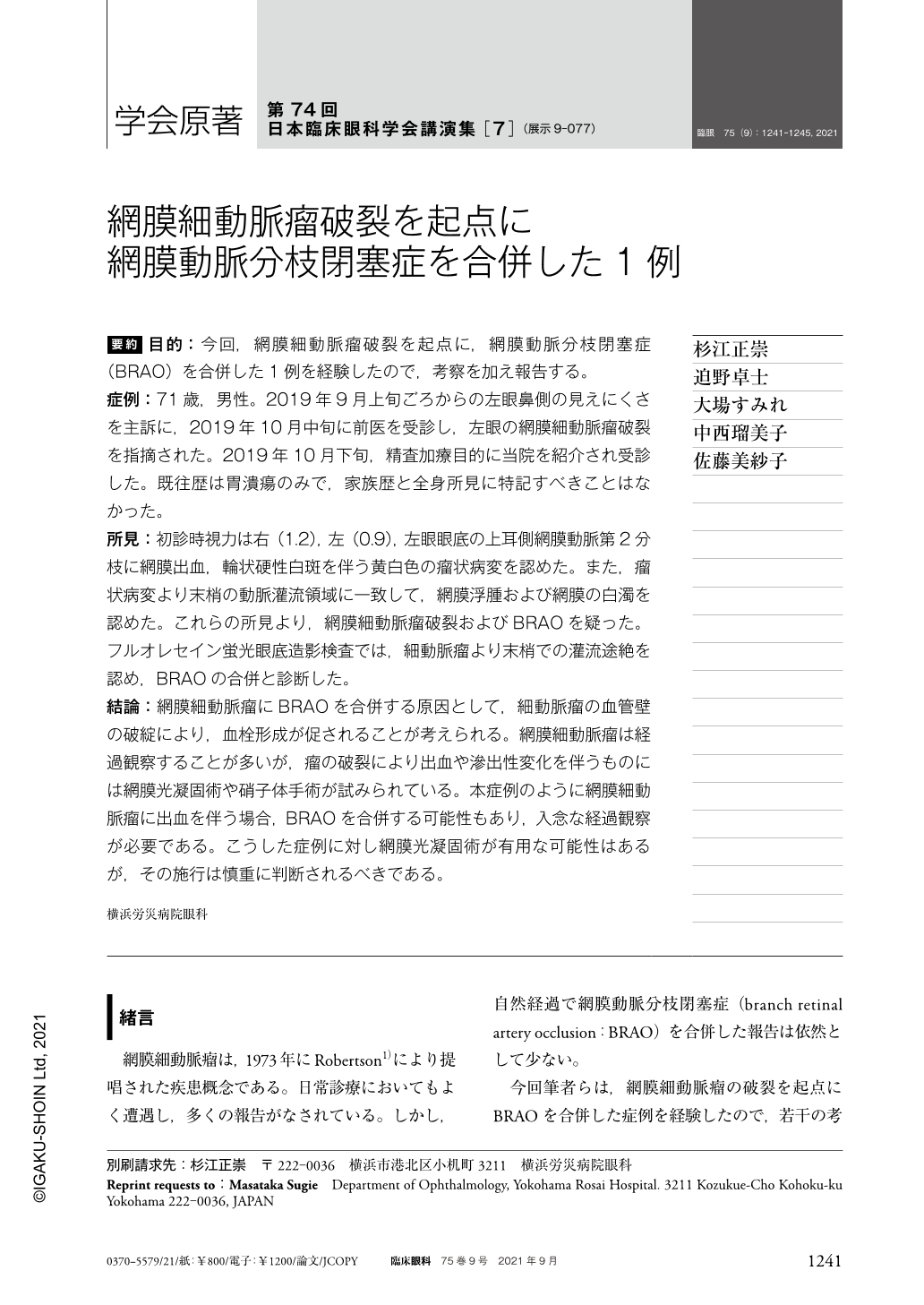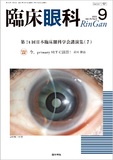Japanese
English
- 有料閲覧
- Abstract 文献概要
- 1ページ目 Look Inside
- 参考文献 Reference
要約 目的:今回,網膜細動脈瘤破裂を起点に,網膜動脈分枝閉塞症(BRAO)を合併した1例を経験したので,考察を加え報告する。
症例:71歳,男性。2019年9月上旬ごろからの左眼鼻側の見えにくさを主訴に,2019年10月中旬に前医を受診し,左眼の網膜細動脈瘤破裂を指摘された。2019年10月下旬,精査加療目的に当院を紹介され受診した。既往歴は胃潰瘍のみで,家族歴と全身所見に特記すべきことはなかった。
所見:初診時視力は右(1.2),左(0.9),左眼眼底の上耳側網膜動脈第2分枝に網膜出血,輪状硬性白斑を伴う黄白色の瘤状病変を認めた。また,瘤状病変より末梢の動脈灌流領域に一致して,網膜浮腫および網膜の白濁を認めた。これらの所見より,網膜細動脈瘤破裂およびBRAOを疑った。フルオレセイン蛍光眼底造影検査では,細動脈瘤より末梢での灌流途絶を認め,BRAOの合併と診断した。
結論:網膜細動脈瘤にBRAOを合併する原因として,細動脈瘤の血管壁の破綻により,血栓形成が促されることが考えられる。網膜細動脈瘤は経過観察することが多いが,瘤の破裂により出血や滲出性変化を伴うものには網膜光凝固術や硝子体手術が試みられている。本症例のように網膜細動脈瘤に出血を伴う場合,BRAOを合併する可能性もあり,入念な経過観察が必要である。こうした症例に対し網膜光凝固術が有用な可能性はあるが,その施行は慎重に判断されるべきである。
Abstract Purpose:Here, we report a case of branch retinal artery occlusion (BRAO)starting from a ruptured retinal arteriole macroaneurysm with some consideration.
Case:A 71-year-old man visited a hospital in mid-October 2019 with a complaint of a visual disturbance on the medial side of the left eye since a month and learned that a retinal arterial macroaneurysm of the left eye had ruptured. In late October 2019, he was referred our hospital for a detailed examination and treatment. His medical history consisted of a gastric ulcer, and his family history and general findings were not particularly noteworthy.
Findings:His visual acuity at the first visit was right(1.2)and left(0.9). A retinal hemorrhage was noted in the upper ear retinal artery of the left fundus along with a yellowish-white nodular lesion with a cricoid white spot. In addition, retinal edema and retinal cloudiness were observed in the arterial perfusion region peripheral to the macroaneurysm lesion. Accordingly, a retinal arterial macroaneurysm rupture and BRAO were suspected. Fluorescein angiography revealed a perfusion disruption peripheral to the macroaneurysm, and the patient was diagnosed with a BRAO.
Conclusions:The cause of BRAO associated with retinal arteriole macroaneurysm is thought to be the promotion of thrombosis due to macroaneurysm wall rupture. Retinal arterial macroaneurysms are often followed up, but retinal photocoagulation and vitreous surgery have been attempted for those with bleeding or exudative changes due to rupture. As in this case, when retinal macroaneurysm is accompanied by bleeding, BRAO is possible, and careful follow-up is required. Retinal photocoagulation may be useful in these cases, but its implementation should be carefully judged.

Copyright © 2021, Igaku-Shoin Ltd. All rights reserved.


